Country Report: The Netherlands
The Dutch healthcare system, dubbed today as a “laboratory for change,” is in the midst of reinventing itself around collaborations with industry and government in such areas as market and patient access, transparency, cost-effectiveness, and process innovation.
This sponsored supplement was produced by Focus Reports.
Report Publisher: Diana Viola.
Senior Editor: Louis Haynes.
Project Director: Marie Kummerlowe.
Editorial Contributors: Alexander Ackerman, Laurent Libano.
Contributors: Lisa Diericks, Maryam Niakouei, Alison Mowat.
Art Director: Carmen Reyes.
For exclusive interviews and more info, please log onto www.pharmaboardroom.com or write to contact@focusreports.net
*Photo: Property of VOZ magazine
In keeping with its reputation as a forerunner, the Dutch healthcare ecosystem is currently reinventing itself to ensure it remains ahead of the game in terms of both innovation and excellence. Market and patient access, transparency, cost-effectiveness and process innovation all feature prominently as industry and government alike band together to forge a more sustainable system in a country that can easily be characterized as a "laboratory for change." "The Dutch system displays immense propensity for innovation in life sciences and health, and any outward-looking pharma firm that takes innovation seriously should strongly bear this in mind," counsels Hans Schikan of Health Holland, the communication channel of the Dutch life sciences and healthcare sector.
Ranked as the best performing of 35 European healthcare systems in the Euro Health Consumer Index (EHCI) for the fifth year in a row in 2015, the Netherlands also wields sufficient credibility, gravitas and willingness to be an important driver of public health policy renewal at a Europe-wide level, leveraging its status as incumbent holder of the rotating Presidency of the Council of the European Union. "We are eager to capitalize on this opportunity to promote joint price negotiation while championing a collegiate approach to public health based on the principles of 'a shared interest and shared responsibility'," declares health minister, Edith Schippers.
Indicative of the sheer importance the Dutch state assigns to healthcare, the "Life Sciences and Health" sector features as one of the nine "top strategic industries" in the EU's 6th largest economy (attaining a GDP of USD 892 billion in 2015). This designation underscores the government's vigorous efforts to reform the sector, encourage translational medicine and bolster a strong track record of stakeholder exchange and public-private partnership.
"There is certainly a growing sense of collaboration between the Ministry and pharmaceutical companies...today, private enterprise is coopted earlier in the process to inform policymakers on our pipeline developments, while, in the past, we were only permitted to submit dossiers rather than to engage in face-to-face meetings," reveals Bert De Jong, general manager Benelux of Sanofi Genzyme.

Hans Schikan, Health Holland
The private sector has also been pulling its weight, and the numbers also look promising in terms of job-creation. "There are presently between 35 to 40,000 high-skilled workers in the Dutch life sciences industry and my target is to help increase that to around 75,000 in five to ten years," proclaims Gerard Schouw, director of Nefarma, the association for innovative medicines. Additionally, there are structural attributes that increase the appeal of the Dutch healthcare and life sciences sector setting it apart from those of sister European economies. "The Netherlands benefits from dedicated Centers of Excellence with strong international reputations, and also well-organized patient organizations, not to mention world class expertise in rare disease treatment," observes De Jong. "It's an environment that certainly presents an interesting learning curve...rather like a smaller version of the UK, where the market is also at a highly advanced stage," agrees Maurits Huigen, general manager of Chiesi.
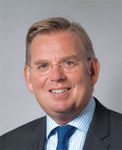
Gerard Schouw, director, Nefarma
SOPHISTICATED, BUT TRICKY
Despite the positive attributes of the Dutch healthcare and life sciences sector, the Dutch market is no bed of roses for drug producers. "We're talking about a rather challenging marketplace where public opinion, and those of the authorities, are often pretty harshly directed towards the pharmaceutical companies. Rightly or wrongly, there's a prevailing public perception that prices of drugs are too high and that pharma companies have been generating unfair profits," asserts Sanofi Genzyme's Bert De Jong. Repeating her appeal to the private sector to disclose the production costs of their medicines and exercise greater transparency over their business models, even Minister Schippers would appear to add credence to such suspicions. "Are the price structures reasonable, or are [the companies] just asking whatever they can get for them?" she asks.
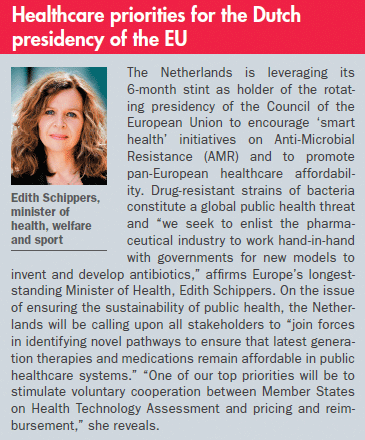
The pharma industry, for its part, insists that such a reputation is unwarranted, and stresses its contribution to securing positive public health outcomes. "Pricing should be responsible and sustainable in the long term, but calling for drastic price cuts is unrealistic and polarizing," suggests Bart Vanhauwere, general manager of Roche, before pointing out that "patients and oncologists perhaps had a tendency to take progress for granted while the industry itself continues to deliver on its promise to bring new, latest generation treatments to patients." The industry moreover still calls for a sincere re-evaluation of its overall impact. "It's really important to recognize that the pharmaceutical industry's public perception is defined by behaviors of certain companies in the past, while the current behavior of the industry has evolved substantially for the better," concurs Chiesi's Maurits Huigen.

Bert de Jong, general manager Benelux*, Sanofi Genzyme
Nevertheless, the market figures also bear the scars of this tough context. "The total cost of pharmaceuticals within the healthcare budget represents only 7-8% of total expenditure, which is actually rather low for Europe. Moreover the pharmaceutical segment of healthcare expenditure in the past few years flat-lined or even declined," warns De Jong. Indeed, forecasts suggest that the market value is set to slowly rise from USD 6.7 billion in 2014 to only USD 7.2 billion by 2020. Many feel that too much emphasis is placed on cost control at the expense of latest generation, innovative therapies that can deliver the best health outcomes for patients. "I feel there is still a huge reluctance from Dutch public authorities when it comes to innovative products. As a consequence, the use of innovative products in the Netherlands is firmly on a downward trajectory, and is now among the lowest in Europe in percentage terms," remarks Isabelle De Walsche, managing director of Gedeon Richter Benelux. Furthermore the barriers to market access only seem to be getting higher with new innovative products having to adhere to stringent medical guidelines, such as ensuring a significant part of the clinical trials process is conducted in the country. "This is a particularly surprising and contradictory in a context where healthcare stakeholders are claiming to seek greater harmonization within the European community," exclaims De Walsche.
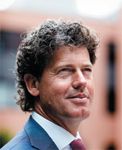
Maurits Huigen, general manager, Chiesi
That is not to suggest that the Dutch generics market fares any better. Although characterized by an apparently sturdy penetration rate of 92% (72% for retail market volume); the reality is that generics represent only 16% of total market value. "Generics prices in the Netherlands are particularly low and comparable to the levels in Germany," points out Martin Favié, chairman of BOGIN, the generics association. "It was a healthy and justified strategy to reduce generic prices, but there has to be a limit. Considering that this is only a mid-size market, some generic companies are going to be tempted to pack their bags and leave the country if prices do not rebound again," agrees Hellen De Kloet, president of the Western-European business operations of the generics company, Sun Pharma. Indeed, projections for the future growth of the generics segment do not look particularly auspicious. "Overall, I would expect that generics growth will plateau at about 75% in volume, and will remain stuck at 15-16% of the market by value," forecasts Favié.

Bart Vanhauwere, general manager, Roche
Wavering between sophistication and complexity, the Dutch market can undoubtedly be characterized as arduous for the pharma industry. Nevertheless, it is also an inspiring case study of how versatile and forward-looking pharma companies are transforming market challenges into opportunities for innovation.

Isabelle de Walsche, managing director, Gedeon Richter Benelux
A DUTCH RECIPE FOR FACING OFF COST-CONTAINMENT
From 2004 to 2013, Dutch total healthcare expenditures increased from EUR 42.5 billion [USD 47.8 billion] to EUR 68 billion (USD 75.6 billion]; 11.8% of Dutch GDP. These eye-wateringly unsustainable public-spending sprees placed the country as second only to the United States in terms of healthcare expenditure in relation to GDP, and above all its European counterparts including France, Switzerland and Germany. Predictably there has since been a backlash with government vowing to take a stance to avoid any further increase. Perhaps more than anywhere in Europe, affordability of care and cost-effectiveness have thus become the major mantras of Dutch healthcare.
One of the most significant changes in recent years has been the transfer of high-cost in-patient medicines to hospital budgets. "Sales of our hemophilia medicines plummeted by around 50% in two years, which was mainly driven by price cuts arising from this [reform]," says Sanne Groenemeijer, general manager of Novo Nordisk. "Prescribers and hospital boards were suddenly faced with impossible decisions such as having to choose between either retaining a nurse, purchasing new equipment, or prescribing an innovative therapy," he recalls. Furthermore, to control any further ratcheting up of healthcare spending, hospitals' budget growth was pegged to an annual rate increase of 1.5% in 2014, now down to 1% until 2017 – while expenditures on intramural medicines are registering increases of 8 to 9% annually, and oncology spending marks growth of 14 to 15% per annum.

Martin Favié, chairman, Bogin
These reforms naturally placed Dutch healthcare stakeholders under tremendous price pressures, with innovative firms alarmed to find their innovative therapies no longer fitting within the scope of public hospital budgets. To continue accessing the market, the heads of innovator pharma companies were thus compelled to take the initiative and identify creative solutions. "The first step was diffusing the hostile atmosphere that had arisen, where the general attitude was that pharmaceutical companies were greedy and aggressive, motivated by nothing but profits. We can understand this emotion in a few instances, but in general it just isn't the way things were," recalls Groenemeijer.
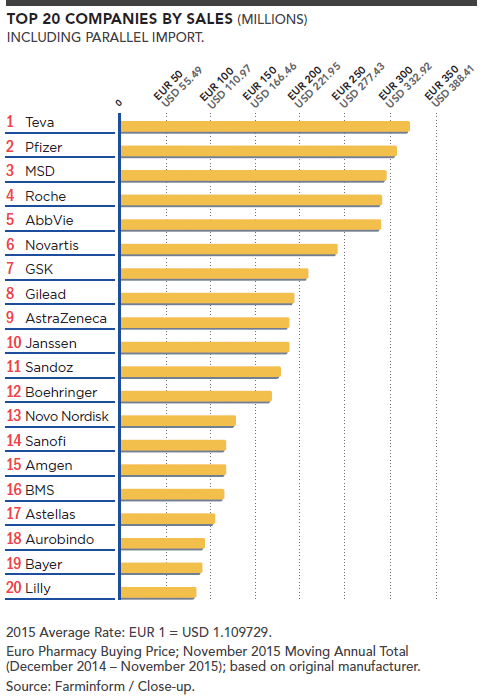
Adopting a Dutch mindset, it indeed appeared that the best remaining solution was to engage even more closely with stakeholders, leading to a thorough transformation of local executives' daily activities and to far greater responsibility being placed on the shoulders of local affiliates. "There are [now] considerably more negotiations, account by account, in order to ensure that there is a clear patient pathway, whereby we precisely agree on who will be paying for which part of the pathway," explains Sean Connor, general manager Benelux, UK and Ireland for ALK. "This situation represented quite a challenge for us at the beginning of 2015, but we have subsequently managed in most cases to secure funding for the relevant patients," he confirms. To support this transformation, local affiliates' structures have also been adapted. "We now evolve at a smaller strategic level by precisely analyzing the situation hospital by hospital. In this regard, the role of our market access department has evolved from a support structure to a true strategic asset - gathering a very precise understanding of the current concerns and needs of all hospitals present on our territory," stresses Aarnoud Overkamp, managing director of Takeda.
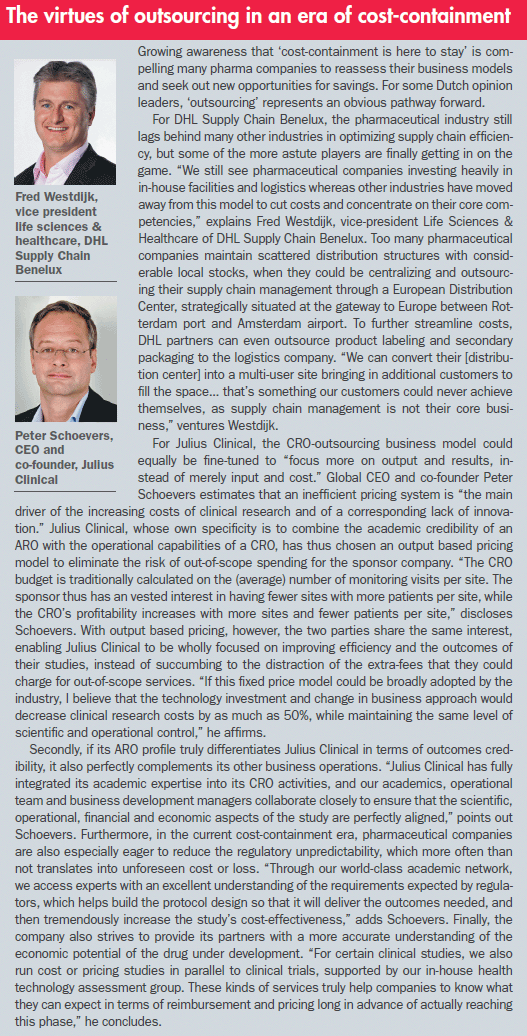
As the current cost-containment context offers limited room for maneuver for many companies operational in the Netherlands, the difference between success and failure tends to rest on their ability to engage more deeply with their counterparts and their willingness to become more transparent and precise in their approach to market. "We feel we have a strong obligation as a partner in gathering and processing the right information," confirms Novo Norsdisk's Groenemeijer. Local affiliates also find themselves having to juggle tighter timelines, as "it is currently more important than ever that products go through the tariff process before the yearly hospitals budget negotiations; otherwise it could happen that both the patients and the company have to wait for another year!" warns Anita Atema, general manager of Celgene. This increased collaboration also offers opportunities for pharmaceutical companies to reshape customer relationship management. "Agility becomes an important part of our strategy, and we strive to quicker address the needs of our customers. Concerning our ability to be more responsive to partners' concerns, the pharmaceutical industry still lags behind many other industries," stresses Takeda's Overkamp.
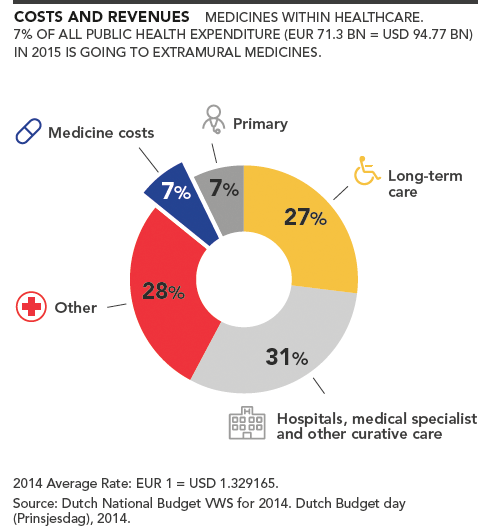
Moreover, reduced market access opportunities also call for a certain form of re-assessment, and above all for more creativity from the industry: two specificities that within such a context can become a true competitive advantage. Groenemeijer, for instance, gives the example of embracing a partial-access pathway for the diabetes therapeutic area. Historically speaking, pharma companies usually seek unlimited market access, yet, "the majority of the roughly 940,000 people living with diabetes in the Netherlands can be effectively treated with either dietary or physical exercise regime changes or with generic therapies," he admits. "When we started discussing "segmented or partial market access" for only a subset of patients, and thus acknowledge that our [innovative] products are not needed for every patient, it's a discussion that [Dutch public authorities] were not used to having," he recounts. Yet this ultimately proved to be a viable solution. "It was the start of our dialogue, to seek constructive collaboration to find the right group of patients who can benefit significantly from our innovation," he recalls.

Sanne Groenemeijer, general manager, Novo Nordisk
Such a context also urges companies to seek out optimizations for treatment efficiency with many companies going down the route of 'process innovation' rather than just 'product innovation', for instance by studying where in the body the drug should be optimally placed to maximize the effectiveness of an API. "Innovation on the overall product level, as opposed to focusing solely on developing new chemical entities, is effective in terms of investment efficiency, and, as such, the added clinical value of such innovative products are also quite efficient from a pricing and reimbursement perspective," attests Chiesi's Maurits Huigen. In the same vein, other companies have also extended this effort to patient education: "it is really challenging to engage patients without being too intrusive, but as always, we will strive to be creative to ensure [they] can benefit from our know-how and better use their treatments," explains Isabelle De Walsche, managing director of Gedeon Richter Benelux.

Sean Connor, general manager Benelux, UK/Ireland, ALK
The Dutch situation of in-patient treatments is another strong example of how companies can bring their treatments to market despite the probability of a return to a more comprehensive reimbursement regime looking unlikely. "Legislators, media, patients, doctors and the public have clearly begun to understand that we cannot pay for everything," says Ad Schuurman, head of international affairs of the National Health Care Institute, the organization in charge of new treatments' assessment for reimbursement. Nevertheless, the Dutch openness to negotiation offers a way out of the conundrum. "There is a strong willingness to look at different methods for reimbursing products from the Dutch authorities," highlights ALK's Sean Connor. "In this vein, the Netherlands can very well be a forerunner in innovating around patient access to innovative medicines, while all the while allowing pharmaceutical companies to still generate reasonable profits in a reasonable timeframe," he adds. From a broader perspective, pharmaceutical companies in the Netherlands can build corporate expertise from the market access innovations successfully implemented in the "Dutch laboratory". "The local market complexity affords many opportunities to [engage in new ways with stakeholders], and the lessons learned [here] can later be applied in other geographies," concludes Wiebke Rieb, general manager of Pfizer. Although the situation of innovative treatments penetrating the Dutch market remains far from being solved, the Dutch innovative spirit is still alive and kicking.

Aarnoud Overkamp, managing director, Takeda
A FERTILE GARDEN FOR INNOVATION
Despite lacking a national champion to bolster its innovative ecosystem since the 2007 acquisition of Organon by Schering Plough, the Netherlands nevertheless still sits in fourth position on the 2015 Global Innovation Index. For the healthcare sector, the country's innovation is notably propelled by a myriad of local success-stories, and particularly by the booming Dutch biotech scene, whose players concentrate their efforts on addressing unmet medical needs, thanks to the development of cutting-edge technology.

Kiadis Pharma, for instance, notably looks to allow "family members to become donors for allogeneic hematopoietic stem cell transplantations (HSCT) to patients suffering from blood cancer," a ground breaking innovation that will "increase the donor pool and almost completely hedges the life-threatening risk associated with donor immune cells attacking the patient. (..) There is no other approved treatment already on the market addressing the same unmet medical need, and there are only one or two similar medical developments underway all over the world," explains CEO Manfred Rüdiger. In the same vein, Galapagos, a Leiden-based biotech company, is developing a safe drug for rheumatoid arthritis that could eliminate usual related side effects, such as anemia, high cholesterol or high level of infection. "In Phase II the efficacy data was the highest reported up to today," explains Galapagos CEO, Onno van de Stolpe.
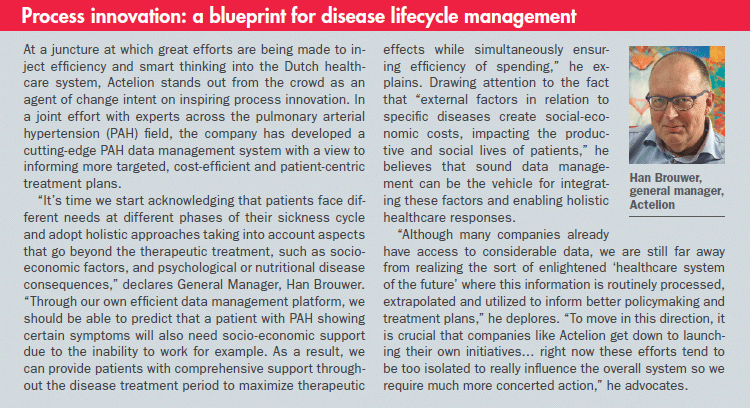
These Dutch companies are already on the radar of some of the industry's major players. Janssen paved the way to the Netherlands in 2011, with the acquisition of Crucell, whose vaccine expertise helped launch the Netherlands-based Janssen Prevention Center. "Thanks to the acquisition of Crucell, we are now able to deepen our expertise in disease prevention for Janssen's five core therapeutic areas. The vaccine platform is obviously particularly indicated for infectious diseases, and the Janssen Prevention Centre is now looking to apply this expertise in other key therapeutic areas, such as dementia, heart failure, and obviously oncology. We could use the immune system not only to treat diseases, but also to prevent their apparition," explains Paul Korte, general manager of Janssen.
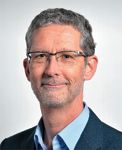
Paul Korte, general manager, Janssen
The interest of global MNCs in Dutch innovation has gathered steam in recent years with a flurry of M&A activity. 2015, for example, was notable for Amgen's headline-catching acquisition of Dezima and its lead cholesterol treatment to the tune of some USD 300 million. "Ten years ago, the Netherlands did not have a strong biotech climate. The types of innovation that emerge in companies like Dezima clearly demonstrate that times have changed," states Jasper van Grunsven, general manager of Amgen. In the meantime, Bristol-Myers Squibb and Amsterdam-based Uniqure closed a strategic partnership to develop gene therapies for cardiovascular disease, while Galapagos and Gilead announced they would collaborate on the global development of Galapagos' treatment for inflammatory disease indications. Also in 2015, AstraZeneca acquired a majority stake in the cancer drug developer Acerta Pharma for USD 4 billion, and Pfizer made an upfront payment of USD 87.5 million for a minority equity interest in AM-Pharma (a company developing proprietary recombinant human Alkaline Phosphatase therapeutics), and gained an exclusive option to acquire the remaining equity in the company with additional potential payments of up to USD 512.5 million.

Jasper van Grunsven, general manager, Amgen
That is not to suggest that partnering with Big Pharma represents the only way forward for Holland's dazzling cast of biotechs, as they already incorporate a very market-oriented approach into their development curves: in 2014/2015, Galapagos, ProQR, Merus and UniQure all went public on Nasdaq, while Kiadis Pharma opted for Euronext. "We entered into discussions with the big brand MNCs, but ultimately decided that it was too early for such a deal, and resolved to retain our independence," explains Rüdiger, Kiadis' CEO. Dutch life sciences start-ups can also rely on highly prized early-stage financial partners, as "the Dutch biotech scene benefits from a flourishing venture capital community, with some of the largest and most successful VC funds in Europe based out of the Netherlands," reflects Hans Schickan, from Health Holland.
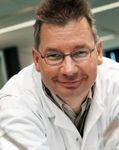
Ruud Santing, CEO, Sinensis Life Sciences
Beside the crucial importance of the financial support available in the country, this burgeoning innovation phenomenon can also be explained by the dense and clustered structure of the Dutch healthcare industry, which operates as a formidable growth driver for new experimentations. "Our main job is to manage interplay within the cluster to maximize connectivity between actors and to work with new innovative companies to help them recognize and achieve their future route," explains Thijs de Kleer, managing director of Leiden BioScience Park, one the top five most successful science parks in Europe.

Ellen Gijsbers, managing director, Fresenius Medical Care
This extreme proximity of different healthcare companies at various stages of development can also benefit the entire healthcare value chain. "We go along the full life cycle of companies present locally. As such, when a biotech neighbor first started here in the Leiden Bio Science Park, they outsourced all their testing to Sinensis. They then raised capital and brought some functions in-house again, but when demand rose, they once again outsourced to us, and today we test their commercial batches, including the post marketing stability studies," reveals Ruud Santing, CEO of Sinensis, an independent provider of laboratory testing and manufacturing services. Being in contact with cutting-edge biotech companies also incites their partners to remain extremely competitive. "We are very fast and flexible. Unlike other CMOs, we have chosen to have a relatively small manufacturing unit, and we have on the other hand developed an impressive analytical laboratory facility. This specific set-up also means that we are able to attract and assist biotech companies earlier in their life cycles. As a matter of fact, our turnaround time for standard analysis is usually twice as fast as the in-house laboratories of manufacturing companies. We thus have clients that do not send samples to their own laboratory, but come to us since we can deliver results demonstrably more efficiently," adds Ruud Santing. Finally, dealing with cutting-edge but relatively small biotech companies doesn't prevent them from attracting bigger international partners. "Sinensis' flexibility, reliability and testing excellence attract a wide variety of customers beside biotech start-ups, as we also partner with multinational generics manufacturers and big innovative pharma players. In terms of geographies, we now have a wide client base all around North-Western Europe, as well as in the Middle-East and India, while our high-end nuclear magnetic resonance (NMR) testing services available at Spinnovation, our chemical testing branch for very advanced techniques, is quite unique on a global level and attracts numerous clients from the United States," he claims.

Hans Hofstraat, vice president, Philips Research
In the upcoming years, the Netherlands's excellent academic ranking and entrepreneurship culture in the life sciences industry will continue to establish the country as a globally attractive innovation destination. MNCs' role in supporting and benefiting from this unique opportunity may well follow the same path. "My message to the local biotech scene is 'please continue doing what you are doing' because there will surely be exit opportunities and continued successes if the Dutch life sciences industry maintains its current course," appeals Jasper van Grunsven, general manager of Amgen.

Yvonne van Rooy, president, NVZ
FORGING THE FUTURE OF HEALTHCARE
The Netherlands is clearly a fertile environment for its 2,200 life science and medtech companies. However, the Dutch ambition to be a frontrunner in new healthcare challenges also comprises an overall approach to treating patients. Aging population, chronic disease, and innovative pharmaceutical treatments' role in extending patients' life expectancies have forced public authorities to reinvent healthcare processes. "Even if patients don't die anymore of certain diseases, they still need to follow their treatments, leading us to the necessity of embarking upon a new era of innovation based on process innovation," explains Minister Schippers.
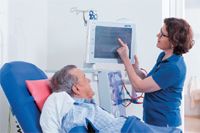
5008 HD machine, Courtesy of Fresenius Medical Care
Dutch medtech companies are already supporting this revolution by moving from a product-centered offering to a more comprehensive approach. "Ultimately, process organization should follow [a] patient-centric approach, to prevent patients from moving around from specialist to specialist," asserts Ellen Gijsbers, managing director of Fresenius Medical Care. "In this regard, our Coordinative Care division adopts a patient-centric approach to tackling the peripheral troubles of kidney patients ensuring patients receive all other additional care services they could need, from pharmacy, vascular, cardiovascular and endovascular surgery services, non-dialysis laboratory testing services, physician services, hospitalist, or urgent care services. Nevertheless, deepening this service offer is currently slowed down by the compartmented system of reimbursement," analyses Gijsbers, in a call for aligning financial and reimbursement schemes with the promising patient outcomes that could offer a more holistic approach to care.
If improving patient outcomes is the ultimate objective of all Dutch healthcare stakeholders; reinventing the relationship between medtech companies and Dutch hospitals is also of crucial importance. Bound by cost-containment, Dutch hospitals are increasingly interested in using industry expertise to improve treatment processes and implement best practices in patient care. This interest undoubtedly provides medtech companies with an opportunity to comprehensively partner with healthcare providers. Siemens Healthcare is one of the foremost pioneers in championing new partnership models with hospitals in Europe, as shown by the recent financing of a new hospital in the Netherlands. "For the EWF [hospital], we indeed went a step further in our collaborative approach, as we decided to finance the hospital, which was completely new for Siemens in Europe. This hospital financing perfectly illustrates that we are ready to increasingly broaden our service offering in the future. For instance, some hospital directors have already asked me whether we would be able to build their hospital entirely!" relates Kees Smaling, managing director of Siemens Healthcare.
Transforming the current regulation around healthcare digitalization takes on a heightened importance, as "about 30% of hospital patients possess chronic diseases. However, the type of medical care required for these patients can be performed from home via all kinds of e-health applications," explains Yvonne van Rooy, president of the Dutch hospital Association (NVZ). Once again, innovation in this regard could come from the Netherlands, and more precisely from Eindhoven. This Dutch city remains the main hub of Philips Research, whose activities are now entirely concentrated on health innovation. Philips wants to integrate healthcare innovation within a broader "continuum of health" that is, "broader than only covering episodes of sickness or managing chronic disease: [it] is something we're all part of, all of the time – including taking steps to ensure we stay healthy every day," explains Hans Hofstraat, vice-president of Philips Research.
NEW HORIZONS?
"For centuries, people living in the Low Countries have been struggling against the sea, and collaboration has always been necessary, leading to the Dutch cooperative or 'polder' model," explains Health Holland's Hans Schikan. Considering its success in keeping the country afloat, the Dutch are extending their polder expertise to build a sustainable healthcare system and champion more harmonized European healthcare.
On the other hand, the innovation question perfectly reflects the ambivalence of the Netherlands: despite being far from attractive marketwise, the country will legitimately draw the industry's attention from a process perspective. Market access strategies, local innovators, and patient care revolution are recent proof of the Dutch tradition of conceiving innovation as a collaborative effort to stay above the tide and move forward. "I think that our healthcare system will look totally different in five years compared to where it stands today," predicts Minister Schippers.
